The program's stated mission was "to heighten the visibility of Milwaukee and Wisconsin's LGBT communities through live public access cable television". For much of its existence, it was sponsored by a varying combination of Gay People's Union, The G/L Community Fund, and Cream City Foundation.
MAKING AIR WAVES: The Queer Program turns 20
Summer in Milwaukee 1991... the city is in the throes of the Jeffrey Dahmer case. The mainstream print and broadcast media are the primary sources of information about the case and, by extension, about gay life itself. Now, beyond the AIDS stigma, a crazed serial killer-cannibal becomes the public face of the LGBT community. To confront the crisis, activists Michael Lisowski and Dan Fons embark on a project that, for one of them, still endures today. On November 4, 1992, from a MATA Community Media studio located in the old Schlitz complex at 2nd and Galena Streets, they broadcast the first segment of The Queer Program.
With Michael Lisowski still at the mic, The Queer Program continues its mission to present an alternative news source for and about the LGBT community. QUEST spoke with Lisowski about the beginnings and highlights of his two decade stint as a volunteer radio host.
QUEST: The first question is an obvious one: why The Queer Program?
Michael Lisowski: The Dahmer case really cast the whole community in a negative light. I knew four of his victims - one was in the Milwaukee gay youth group. Lots of people knew them. Dahmer himself was a familiar face in the bars and the rumors were flying. Dan Fons was active in ACT-Up and we both worked for ARCW (AIDS Resource Center of Wisconsin.) We wanted a new means of communicating our side of things. We decided to create a Cable TV program and call it The Queer Program.
QUEST: Was this the Milwaukee's first LGBT cable program?
ML: No, before that there was a show called Tri-Cable Tonight founded by Mark Behar and Brice Clark. It was a prerecorded bi-weekly show. I was the co-host. But, The Queer Program was the first live broadcast. MATA had introduced a new system, M-PACT, that allowed us to do a live show. It was a system with two stationery cameras. One focuses on the talent and the other faces down vertically to allow showing photos, newspapers or fliers. It was a simple operation with a static unmanned camera. A console allows the host to switch cameras or show videos. MATA offered us a studio to do a live program using their new system. We took the required MATA training, did some pilot episodes, then, a year after the Dahmer trial, we broadcast our first live show.
QUEST: Speaking of sponsors, what are the costs of doing the The Queer Program and where does the money come from?
ML: We were initially sponsored by the Gay People's Union (GPU). Now MATA membership is $200 per year for an organization. The G/L Community Trust Fund supports us with an annual grant. Back in 2007 Cream City Foundation celebrated its 25th anniversary and we received $250 from a special fund set up for the occasion by Joe Pabst. Last December CCF gave us $1000. Other costs are out of pocket.
QUEST: That's it?
ML: Three or four years ago CCF funded a project I organized with the LGBT Community Center to train Project Q kids about TV production. The idea was for them to produce their own show. Sadly, nothing came of it after the grant award. I returned my part of the grant. Efforts are still underway to get Project Q involved. I'd love to see them come on and do something that would reach other kids at home who might not yet be aware of what's available to them. QUEST: What was The Queer Program format? Has it changed over the years?
ML: At first it was Dan and I as co-hosts. The original show was 30 minutes and aired on Tuesdays but it was later expanded to a full hour. We presented news and events in the gay community. Dan filmed a lot of the Act-Up protests. We'd show the videos and comment on them and invite guests for interviews. The show would be done live and recorded for a later replay. Sometimes we'd have to edit content or fix technical glitches for the replay. It's pretty much the same today. We moved to the new MATA location on Clybourn Street in 2001. Our time slot changed as well. We're on Mondays at 6pm now. We now have a Health & Wellness booth at PrideFest. We tape people telling what they like about PrideFest and broadcast it. We actually did a show from PrideFest when it was back Veterans' Park. We've always wanted to have a gay dating game. With call-in contestants, the guest would pick a winner. No one seems to brave enough to be a contestant.
Co-hosts have come and gone. In 1993 we had Melanie, a black lesbian. Dan left for San Francisco in September '96 and I went solo for a while. Then Charles Daniels (aka Charles D.) came in. He had been on before promoting pageants, and all. He stayed for 8 or 9 years. A viewer named Tim joined in and the three of us co-hosted. Charles' other community work required him to leave and Tim moved on. So, for a while I was alone again. Currently, Deonte "D" Goodwin, is my co-host. He's been with the show since '07.
QUEST: Do you have any particular memories to share?
ML: Many. We covered some significant local news events, like the Act-Up and Queer Nation protests around HIV/AIDS issues. There was the cryptosporidium outbreak in 1994...104 people died and most were HIV patients including Dan Fons' brother Chris. I remember one of Dan's pet peeves was closeted politicians. He was always trying to out them. In September '96 the Shepherd Express ran an article "Herb Kohl has a Queer Problem" We opened the show with the Hallelujah chorus because Dan was so happy the mainstream media finally covered the story.
We once had a video clip for Valentine's Day of gay guys kissing. MATA slapped our hands for it but they didn't forbid us from showing it. So, we showed it again. It caused a bit of consternation.
QUEST: You've been on for 20 years. Have there been other LGBT TV shows?
ML: Dan and I tried to inspire other organizations to do shows as well. Surprisingly only a few responded. With the ones that did, we turned Tuesday from 630- 9pm into gay night on public access TV. BestD Clinic would start out for 1/2 hour, then The Queer Program, followed by Gay By God's Will, an LGBT religious show hosted by Lew Broyles, the pastor of Milwaukee Metropolitan Community Church. There was even a locally produced gay soap opera. It ran for 5 or 6 episodes. The story line involved a gay bashing, the embittered victim, played by me, and the relationships around him. It just ended abruptly. We never finished it. So, for years we had a lot of LGBT programming but the other shows faded away. The last, BestD Clinic's program continued until 2001.
QUEST: You mentioned interviews. Who were your special guests?
ML: There's a long list including most of the region's LGBT movers and shakers like Maria Cadenas, Brenda Coley and Ray Vahey. Political personalities include Tom Barrett, Sheriff Clark, and Marvin Pratt. Most famous would be Wilson Cruz. He was a TV star who came out in the mid-90's. I called him and we did a phone interview. Entertainers like John McGivern and Aiden Bay, a gay pop singer, have been on as well.
Initially when I interviewed people from organizations, it was pure PR... the good work they do etc. Then I became more investigative. You can't come on to just read a press release. I don't read the riot act but I want real honest answers. If they promote a program and I know nobody comes to it, I'll ask about it. When the LGBT Center's new leadership came on, I asked questions that touched on things that might not have been be so comfortable to answer. Our community needs to know about the status of our larger organizations. They get lots of money through federal and other grants. People should know how it's being spent. I ask some difficult questions about finances or internal workings. If the answers are evasive, I call them on it.
QUEST: Who would you like to have on?
ML: My wish list would be Joe Pabst, Gwen Moore, and Tammy Baldwin.
QUEST: There's a variety of shows on public access TV. As MATA's only current LGBT production how do you co-exist with the other producers?
ML: We all get along. Lots of religious shows jumped on the cable show band wagon. As a producer I've always stood up for them. Others are irritated by their stance on LGBT issues. But I believe in the 1st Amendment. I take advantage of it and believe they have the right to as well. There have been some issues. At one time, an Islamic program came on after BestD Clinic. It got back to us that they would disinfect the studio after the BestD people left. We reported them and the MATA administration told them not to do it. On the other hand, the son of one of the religious show producers would come to us for condoms.
QUEST: For all your years as a community volunteer, aside from a little funding, have you or the The Queer Program received any other recognition?
ML: We were awarded The PrideFest Medal for Community Service in 2012 and two community services awards from Cream City Business Association.
Recently, the Queer Program entered two of its best shows in the Wisconsin Community Media Video Festival. One was boradcast July 16, 2012. It highlighted Gretchen Mead, from the Victory Garden Imitative and Paul Fairchild from CCF, and Paul Williams of the LGBT Community Center, and the collaboration of those groups. It was one of the smoothest shows. The 2nd entry includes an interview with two national co-chairs of NABWMT (National Association of Black and White Men Together), Daryl Fore of Cleveland and Mark Behar of Milwaukee. We spoke about the importance of the country's first interracial gay organization. The awards are in April. Hopefully, one, or maybe both will be recognized for an award.
QUEST: So, over all the years, for all your effort, what has been the community response?
ML: Viewership is hard to estimate. Public access wasn't included in (cable viewer) surveys. The station itself wasn't even formally listed in papers. Of course, there was no internet when we started so we had to do our own promotion with flyers and advertisements in the gay papers. If we knew we'd have a guest on in advance we'd do a press release. We've always had a pink triangle or a rainbow flag in the background so if people would stumble on us while channel surfing, they'd know we're a gay show. Over the years I'll be out and about and someone will recognize me. I've even been asked for my autograph. Once I was stopped while shopping. A very handsome gentleman asked if I still did the show. I said yes. He then asked me if I accepted Jesus into my life. I said I did and he moved on. I don't know if he was disappointed but I was. He was very attractive.
We also have call-ins. We named one "the Flusher". We'd answer and all we'd hear was a flushing toilet. He called for months. Otherwise, we've had our share of crude and obscene homophobic crank calls. Sometimes we have to cut them off because of MATA rules.
But overall most calls are positive. One time I had a friend's son on the show. A caller complained about it but then the mother called in and defended me. A young and very intelligent man calls in occasionally. He says he not gay but discusses things with a lot of insight. I really enjoy callers who just say how much they like the show and our coverage of events and the community. When you get a call like that you realize "it's worth it."
A Celebration of The Queer Program's 20th Anniversary takes place at the Milwaukee Gay Arts Center 703 South 2nd Street (one block north of National Avenue) Friday, March 15 from 7:30 to 9:30pm. All are cordially invited to attend.
In May 2013, the Wisconsin Community Media's 15th Annual 'Best of the Midwest Video Festival' awarded two Merit awards to The Queer Program for two 2012 programs. The first was for the July 16, 2012 program "Weed Dating: The Victory Garden Initiative", featuring guests Gretchen Mead, Director of Victory Garden Initiative, Paul Fairchild, Executive Director of Cream City Foundation, and Paul Williams, Co-President of the Milw. LGBT Community Center's Board of Directors. The second winning entry was for the October 22, 2012 program "The National Association of Black and White Men Together", featuring guests Mark Behar, National Chair of the NABWMT, Milw. LGBT activist, and Darryl Fore, National Co-Chair of the NABWMT, from Cleveland, OH.
But the program's days were numbered. The Warner Cable Access facility was shut down in 2017, and with it, The Queer Program celebrated 25 years of broadcast with their final episode in November 2017.
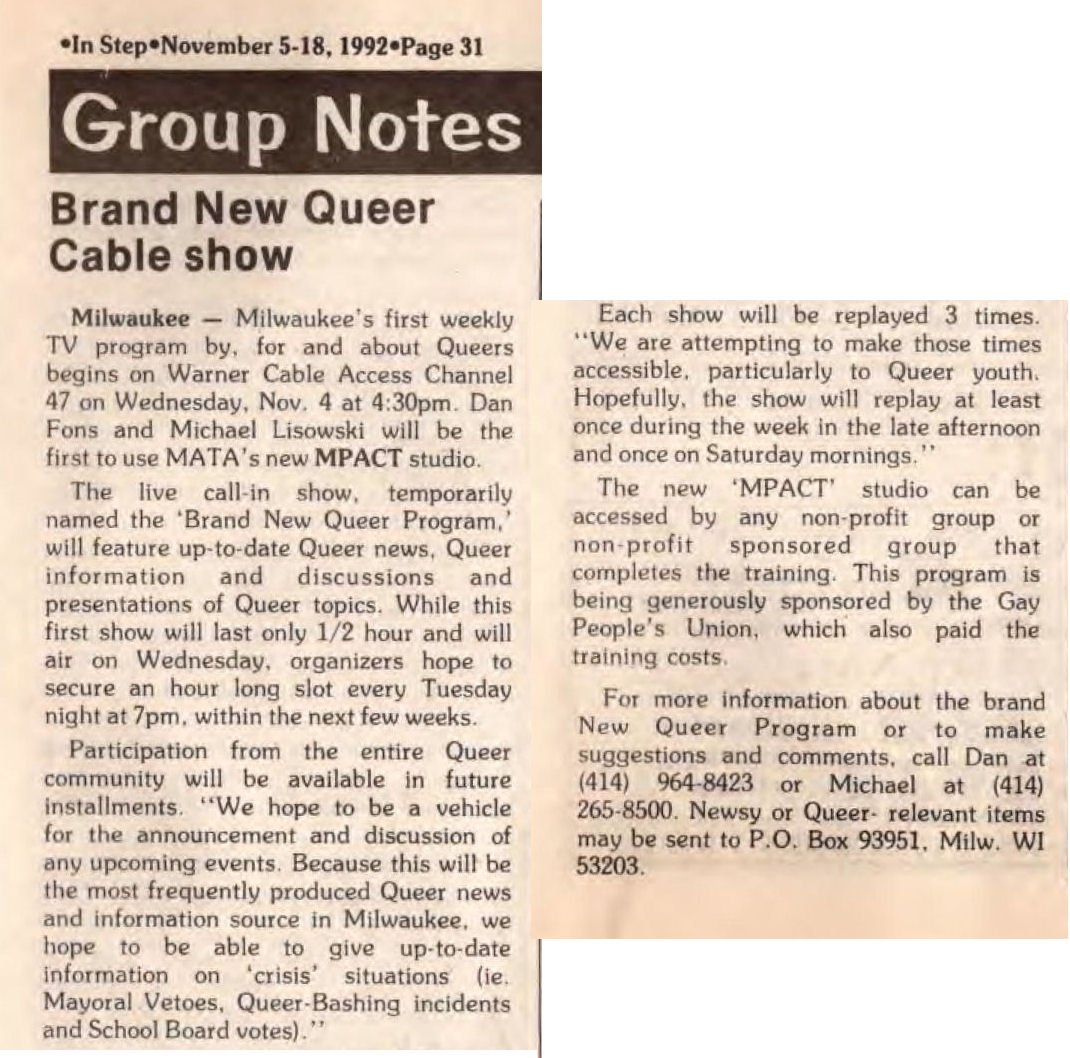
|
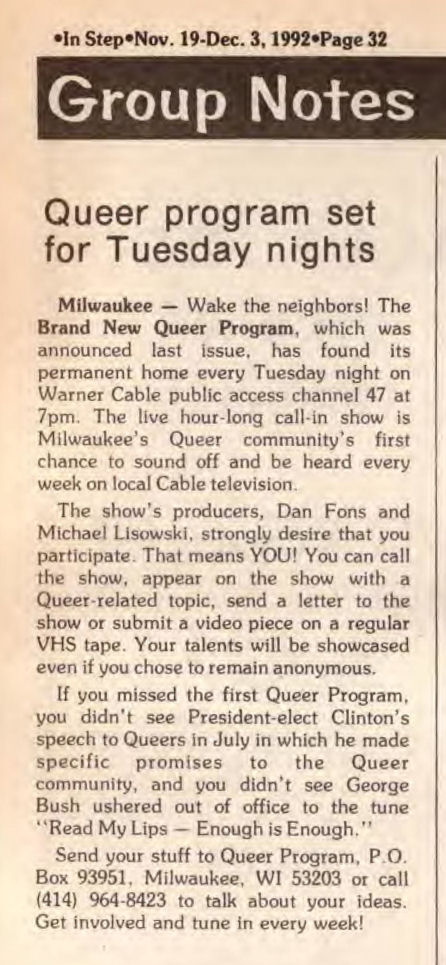
|
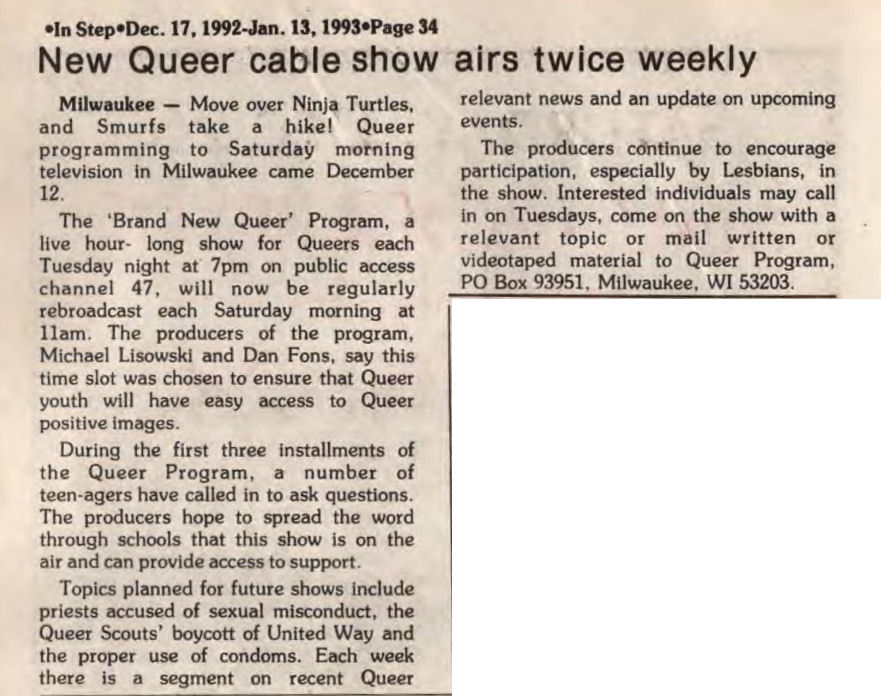
|
|
First mention of new cable show
(In Step vol. 9-22, Nov. 1992)
|
Queer Program set for Tuesday Nights
(In Step vol. 9-23, Nov. 1992)
|
Article: New program airs twice weekly
(In Step vol. 9-25, Dec. 1992)
|
Top-of-Page |
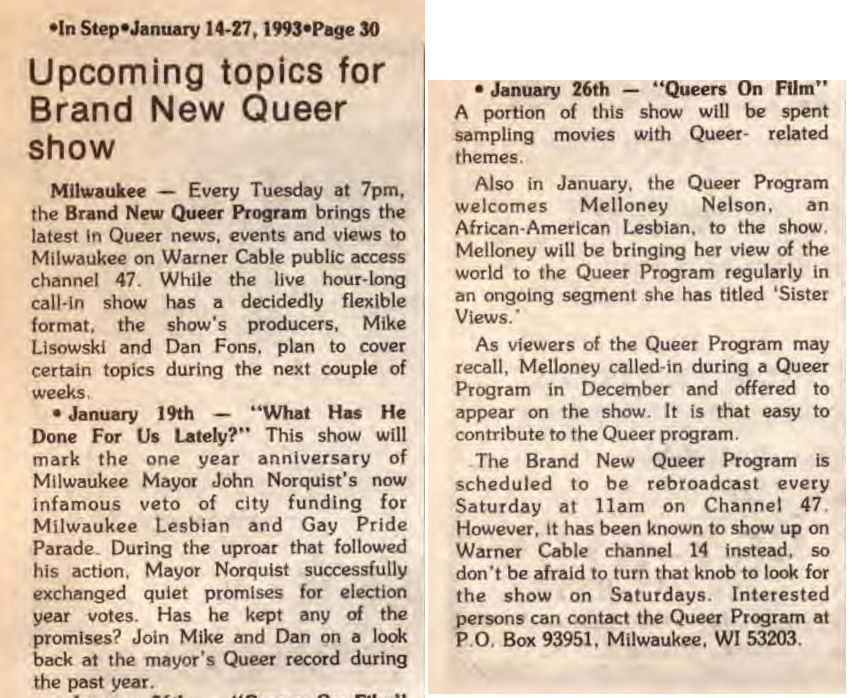
|
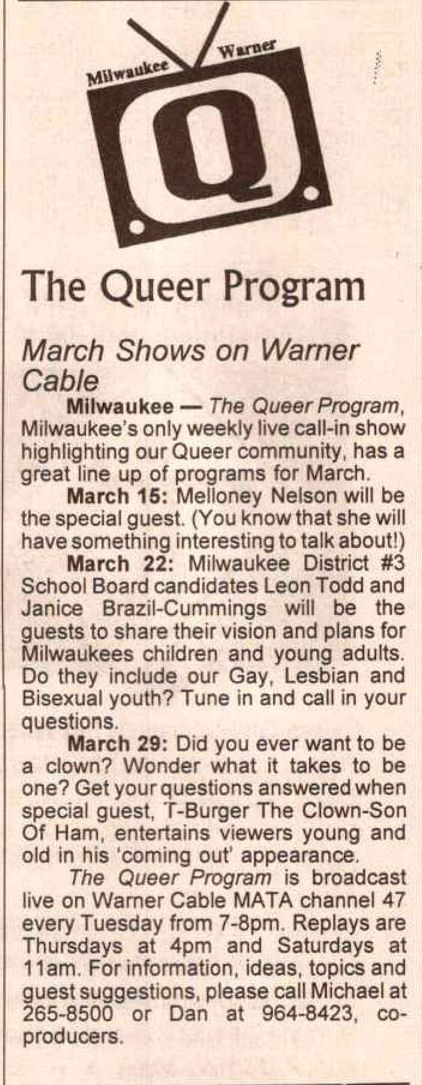
|

|
|
Article: Upcoming topics on show
(In Step vol. 10-01, Jan. 1993)
|
Article: March show schedule
(In Step vol. 11-05, March 1994)
|
Article: Show to analyze election results
(In Step vol. 11-22, Nov. 1994)
|
|
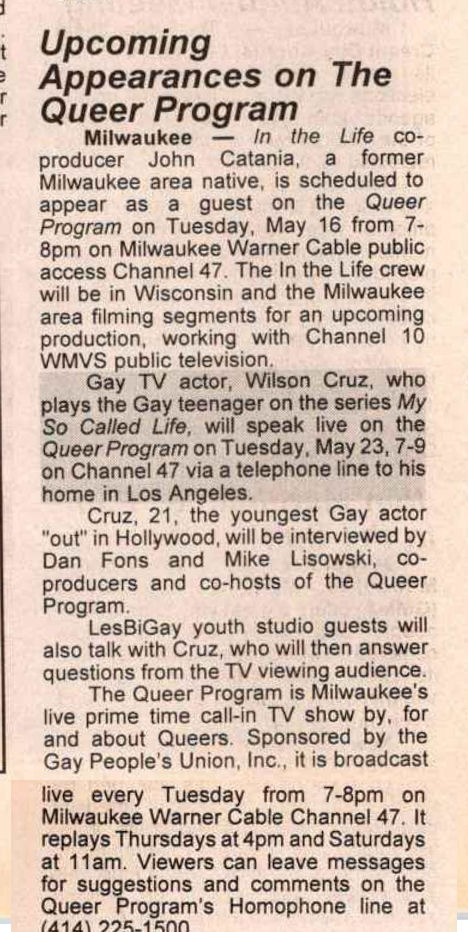
|

|
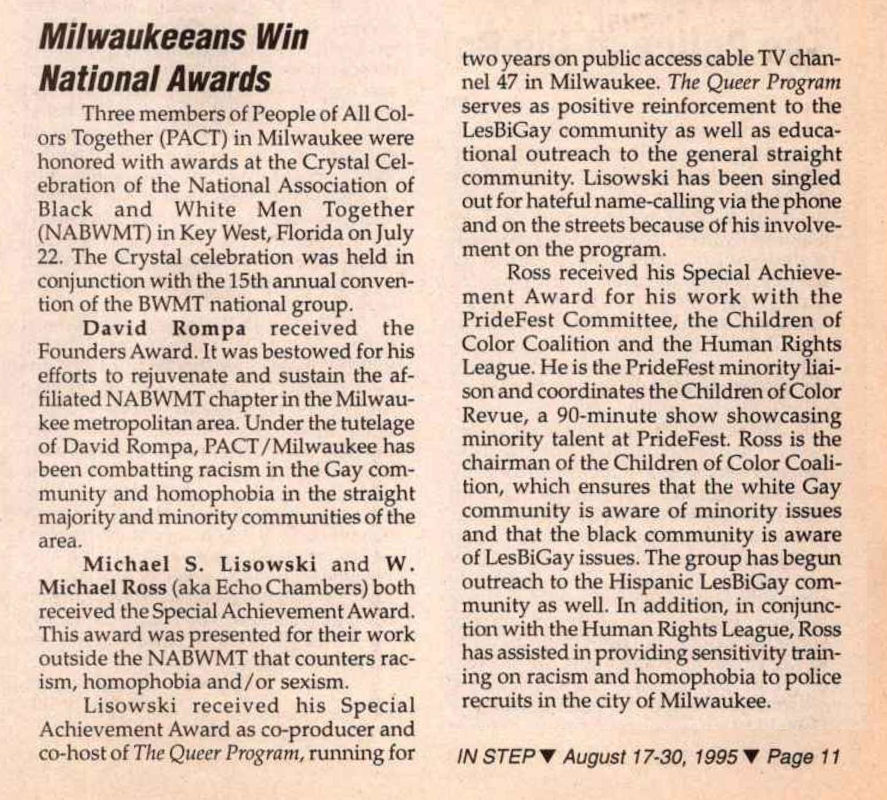
|
|
Article: Upcoming appearances
(In Step vol. 12-09, May 1995)
|
Article: to tape shows at Pridefest
(In Step vol. 12-11, June 1995)
|
Article: National cable program awards
(In Step vol. 12-16, August 1995)
|
Top-of-Page |
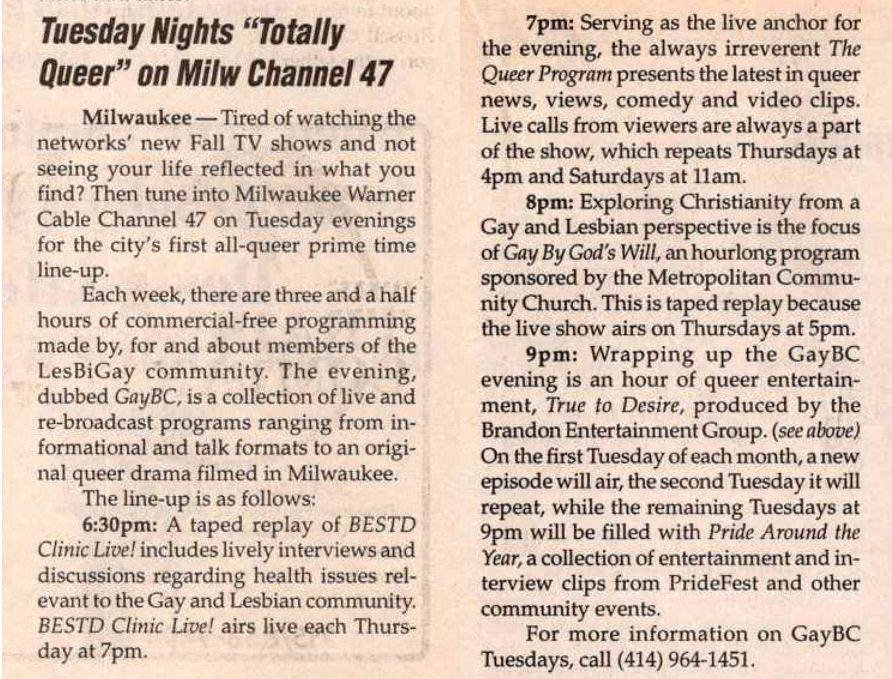
|
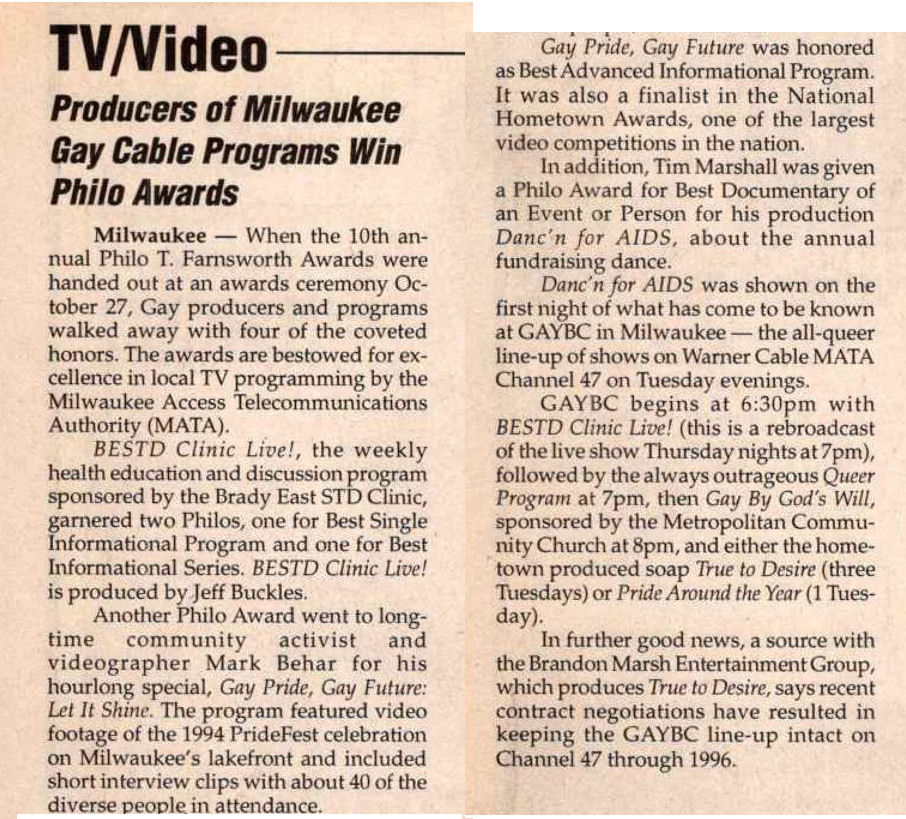
|
|
|
Article: Tuesday nights 'Totally Queer'
(In Step vol. 12-19, Sept. 1995)
|
Article: Queer program part of GAYBC, all-queer lineup of shows on Warner Cable on Tuesday nights
(In Step vol. 12-22, Nov. 1995)
|
|
|

|

|

|
|
Article: Queer Program weekly call-in show
(Quest vol. 11-24, Dec. 2004)
|
Ad: 'One Milwaukee, One LGBTQ Vision'
(Queer Life vol. 1-09, August 2005)
|
Diversion of Day: Mike Laforest guest,
2006 Green Party candidate for Wis. Atty General
(Quest vol. 14-19, Nov. 2007)
|
Top-of-Page |

|
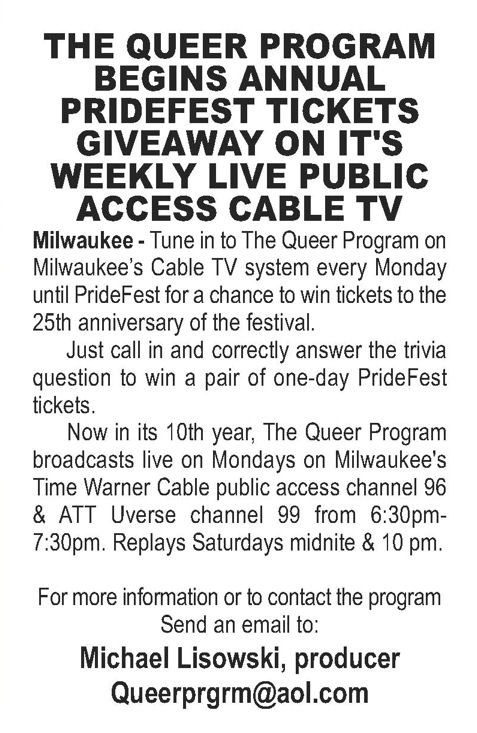
|

|
|
Article: August guests announced
(Quest vol. 16-13, August 2009)
|
Article: annual Pridefest ticket giveaway
(Quest vol. 19-05, May 2012)
|
Article: 2012 wrap-up article mentions
Queer Program twice (columns 2 & 3)
(Quest vol. 20-01, Jan. 2013)
|
|
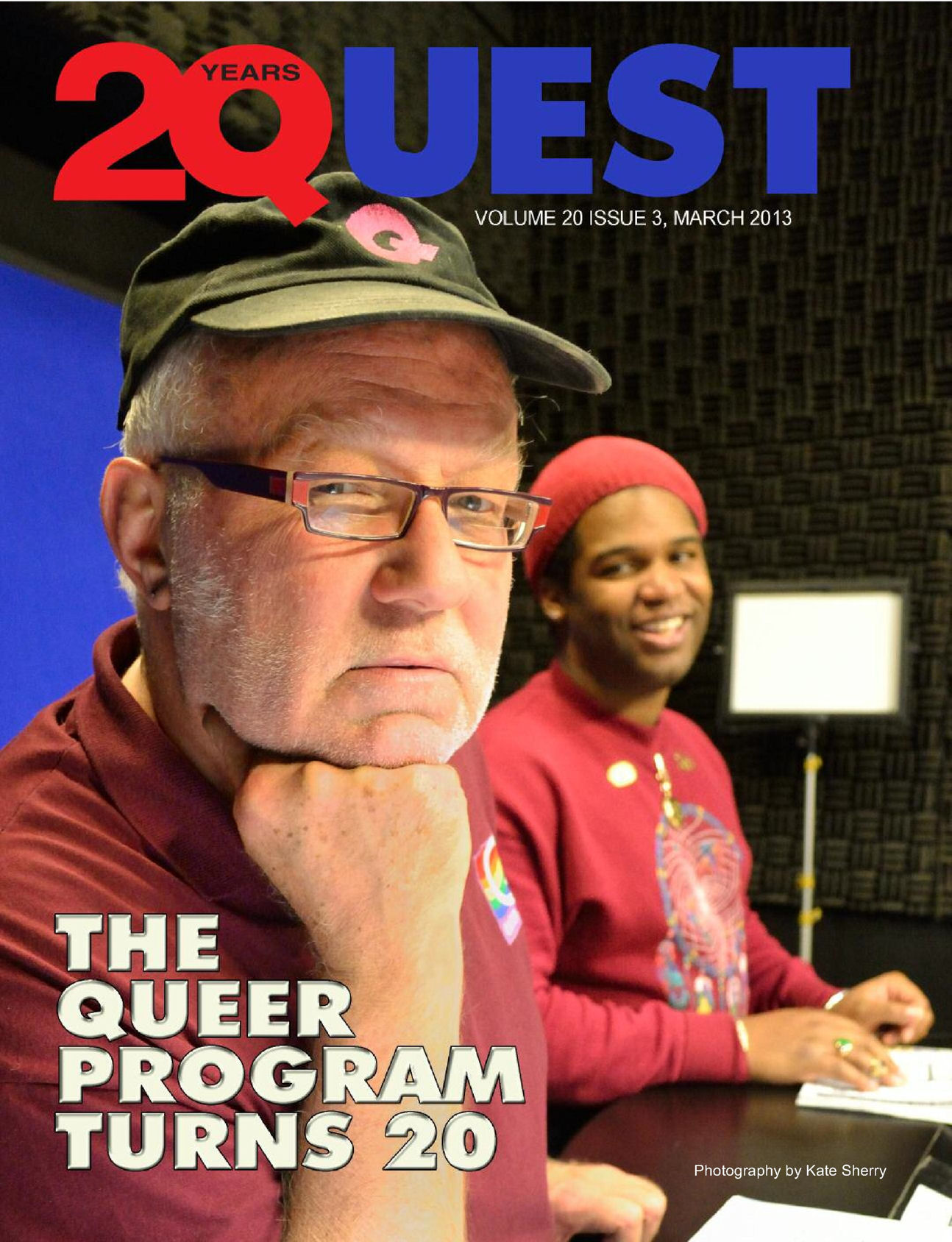
|

|
|
Cover: The Queer program Turns 20
(see article below)
(Quest vol. 20-03, March 2013)
|
Photos: from The Queer Program 20 year party
(Quest vol. 20-04, March 2013)
|
Top-of-Page |
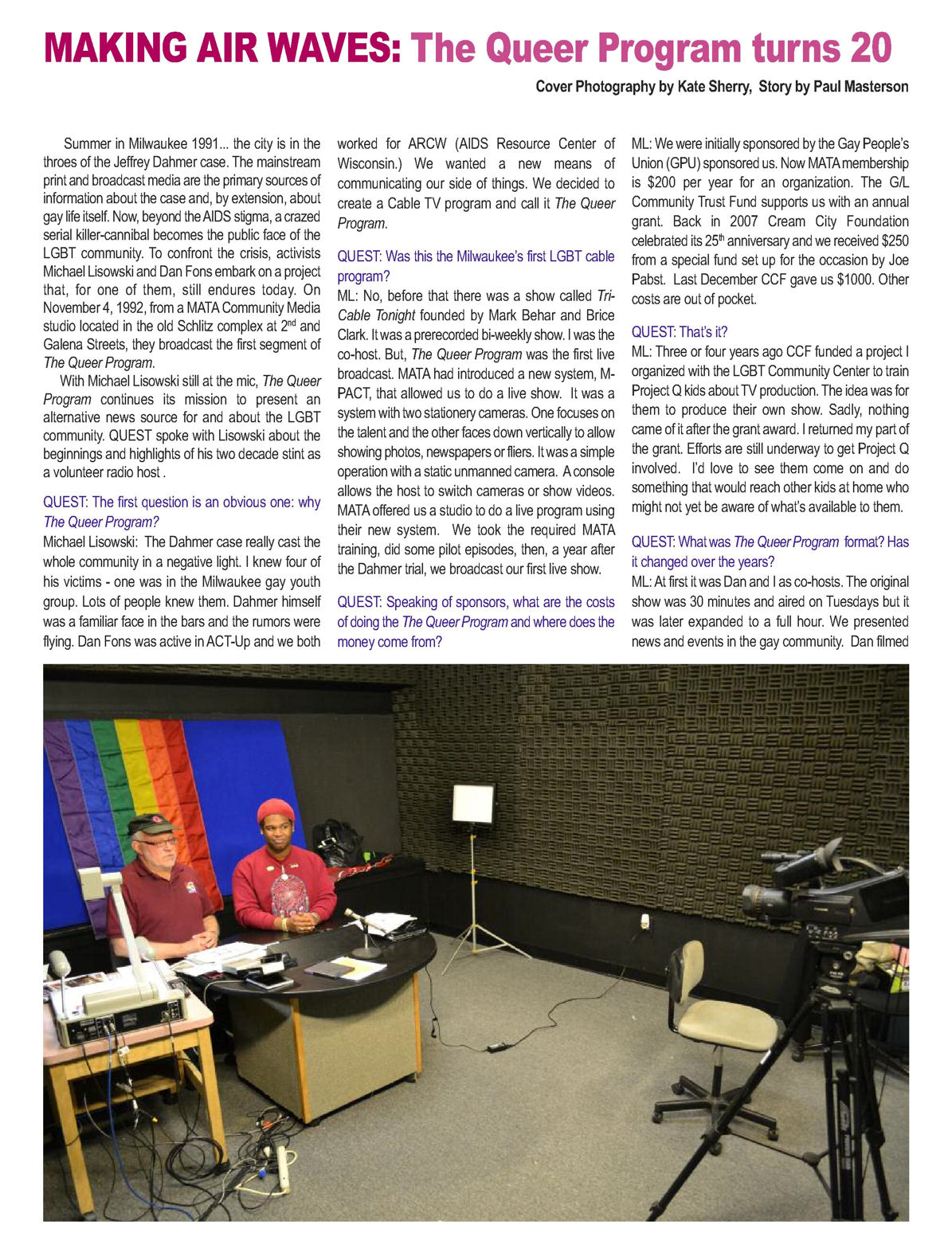
|
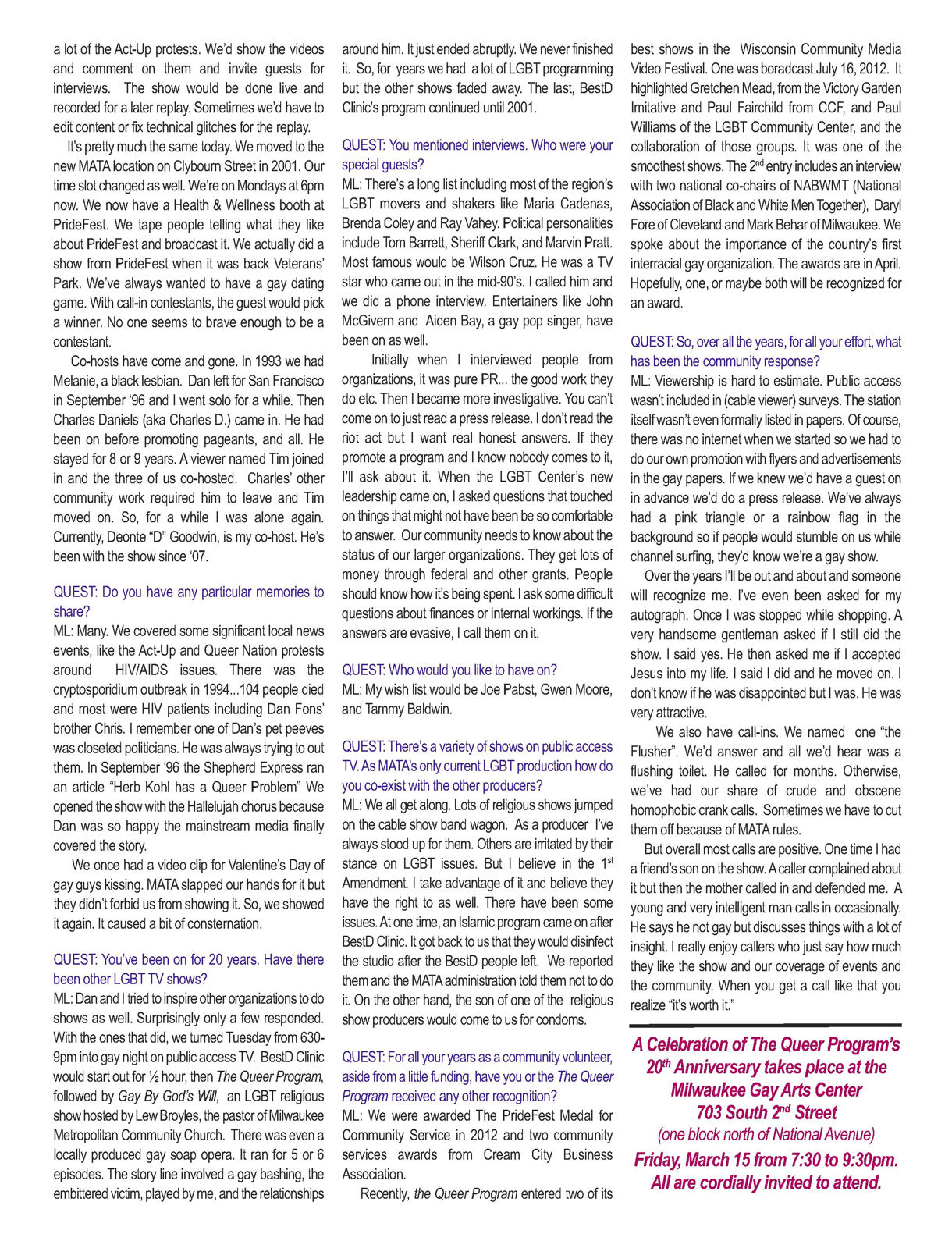
|
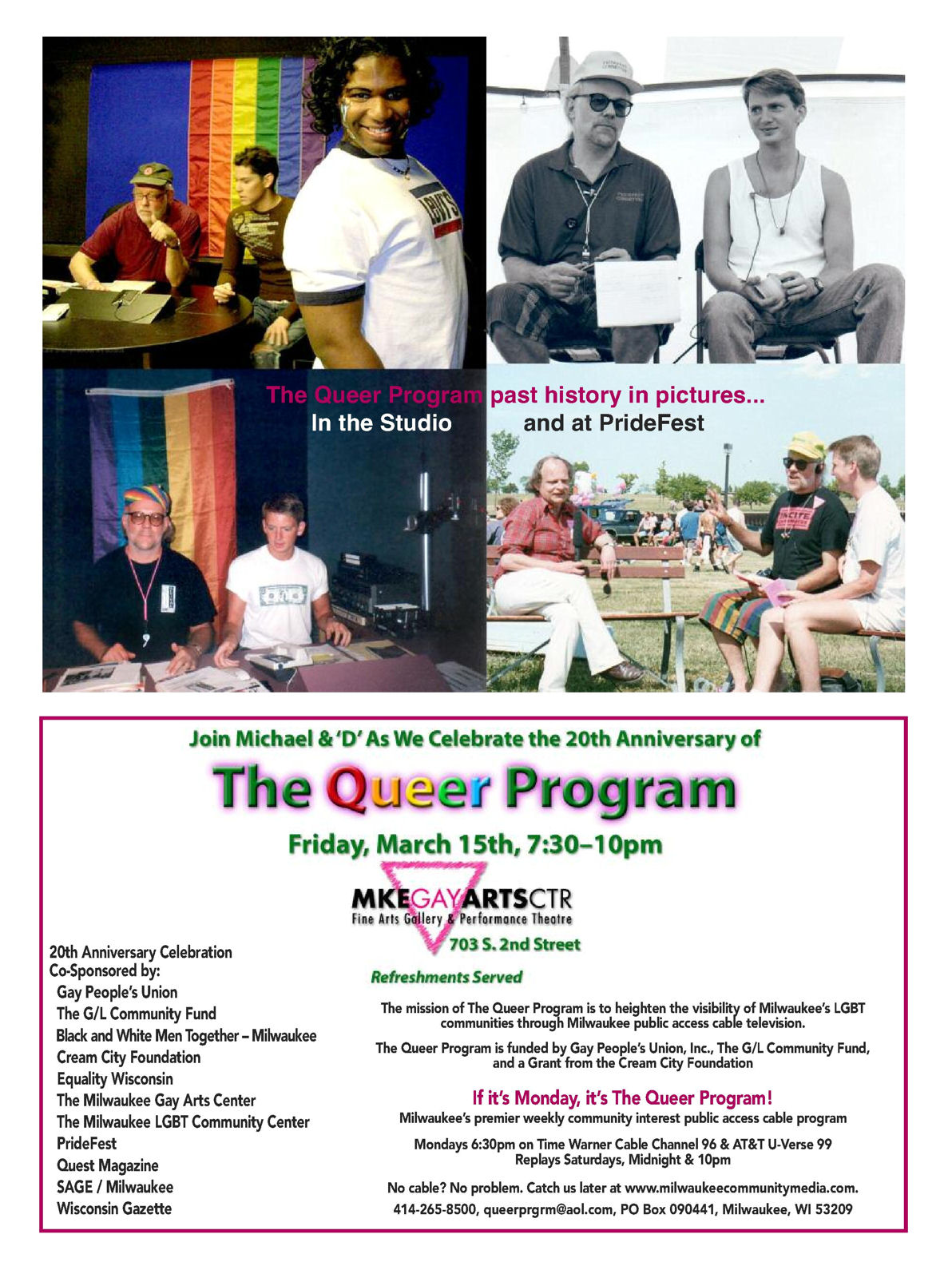
|
|
Article: The Queer program Turns 20
(full text in article above; see cover directly above)
(Quest vol. 20-03, March 2013)
|
|
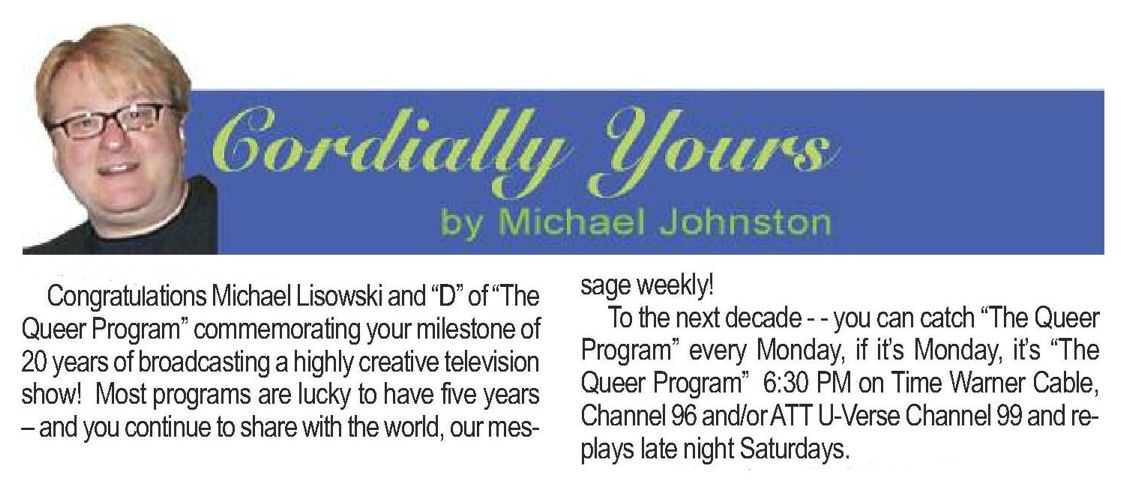
|

|
|
|
Cordially Yours column:
Congratulations for 20 years
(Quest vol. 20-04, April 2013)
|
Article: The Queer Program receives
Merit Awards
(Quest vol. 20-05, May 2013)
|
|
Top-of-Page |
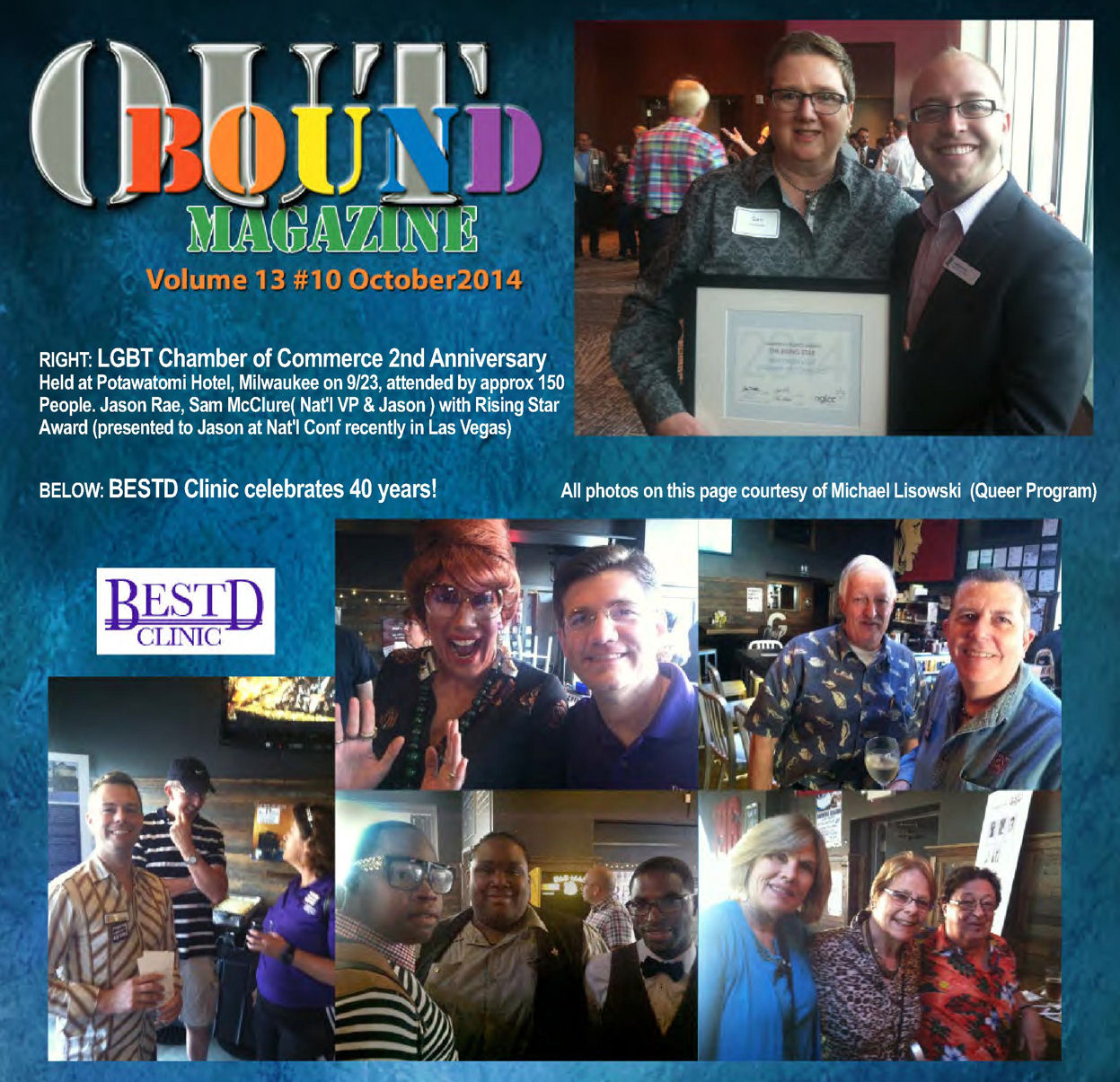
|
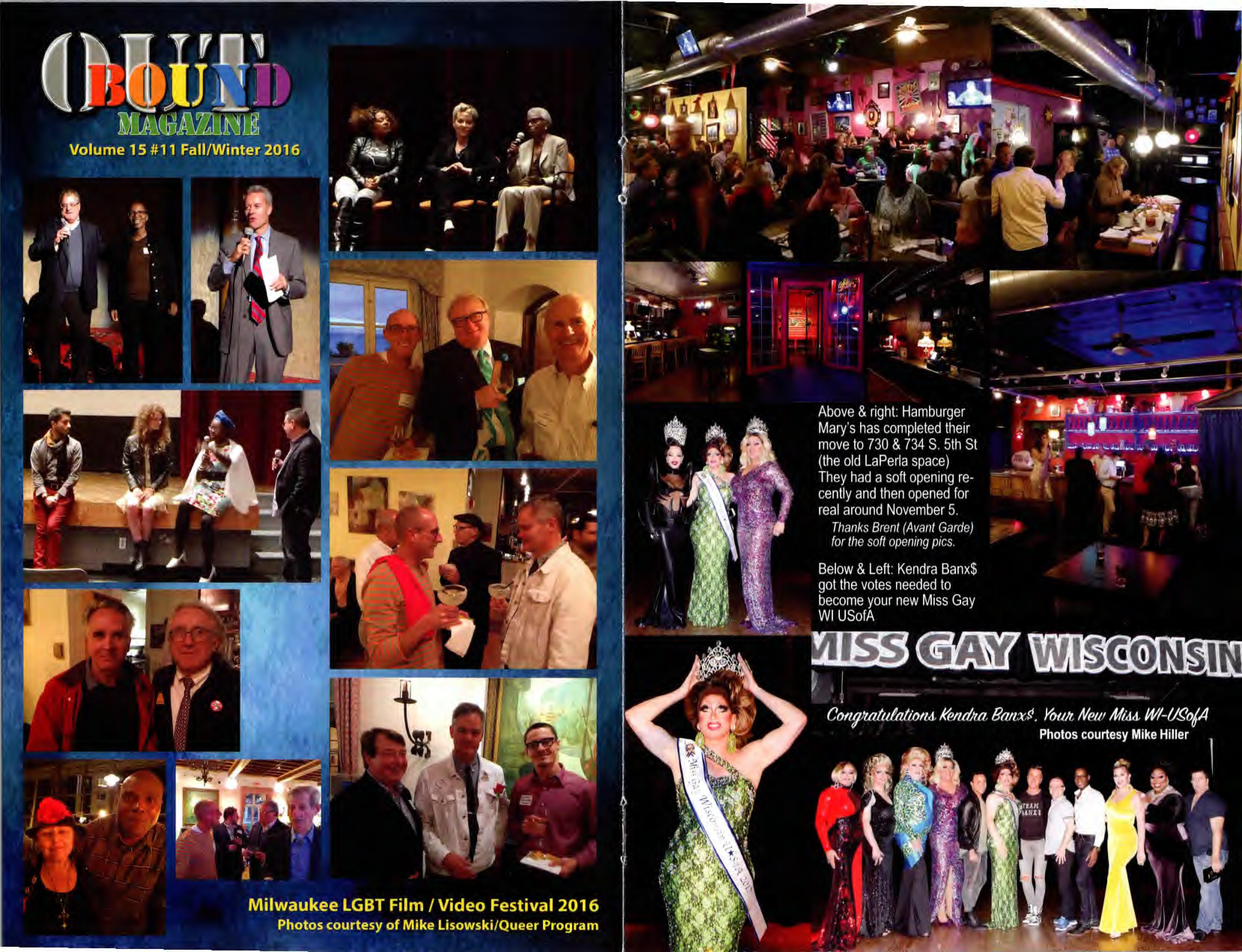
|

|
|
(Queer Program host Michael Lisowski so frequently attends events and meetings of other groups that his photos are often featured in Quest magazine)
(Quest vol. 21-10 and 23-11, Oct. 2014 and Nov. 2016)
|
Article: Pridefest ticket giveaway
(Quest vol. 23-05, May 2016)
|
|
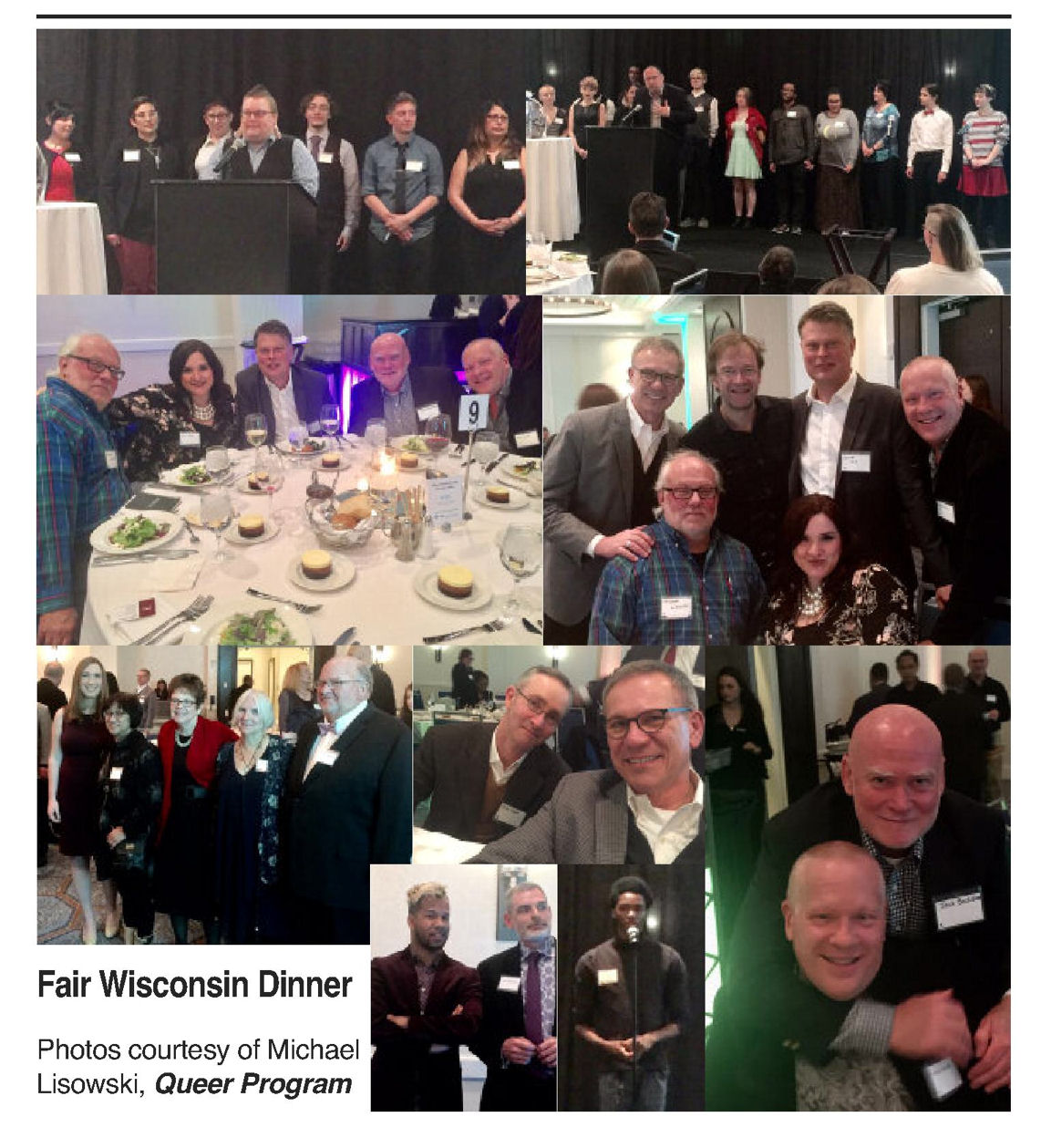
|
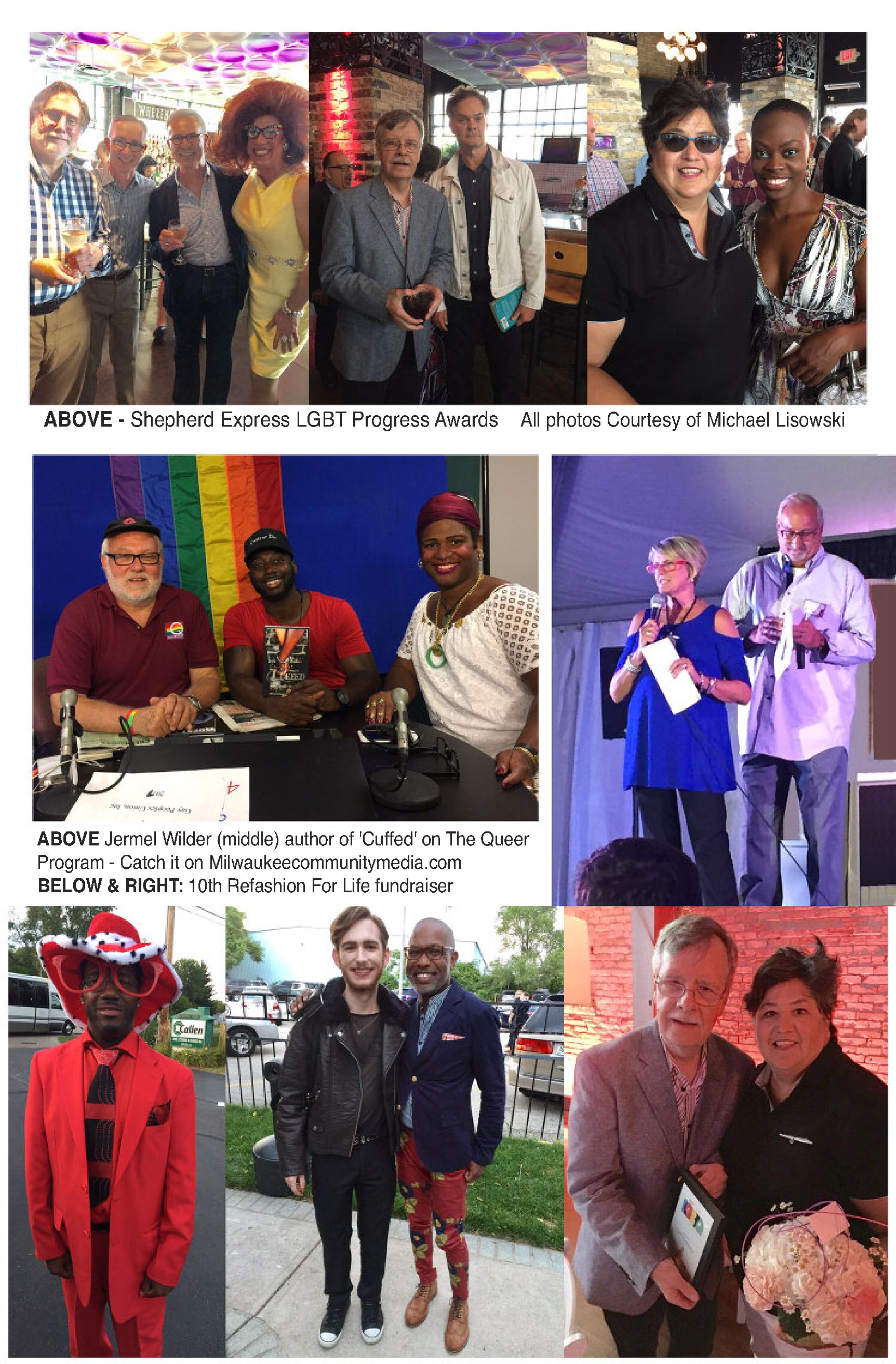
|
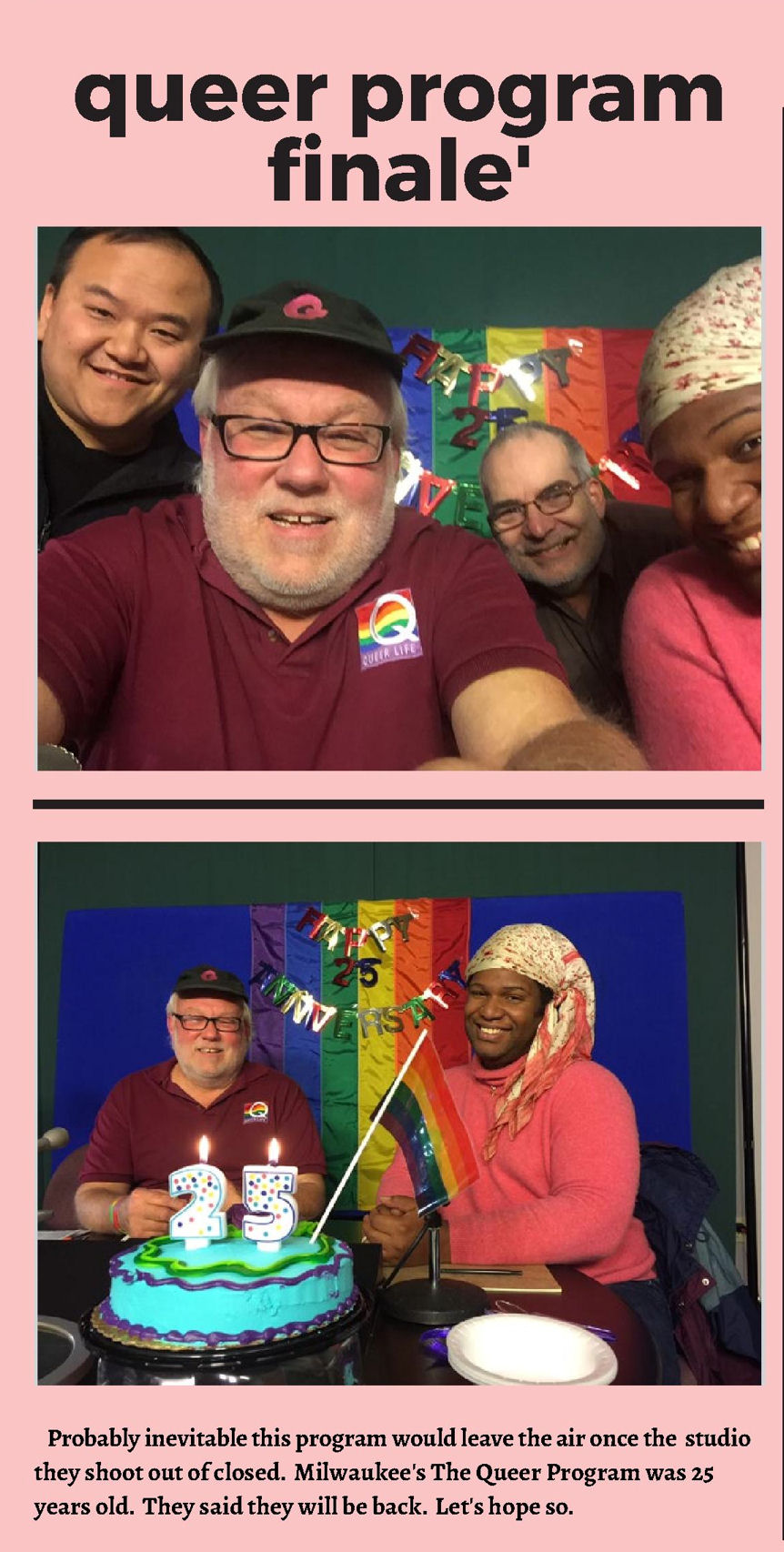
|
|
(Queer Program host Michael Lisowski so frequently attends events and meetings of other groups that his photos are often featured in Quest magazine)
(Quest vol. 24-02 and 24-07, March & Sept. 2017)
|
Photos: Finale; 25 years and last program
(Quest vol. 24-09, Nov. 2016)
|
|

|

|
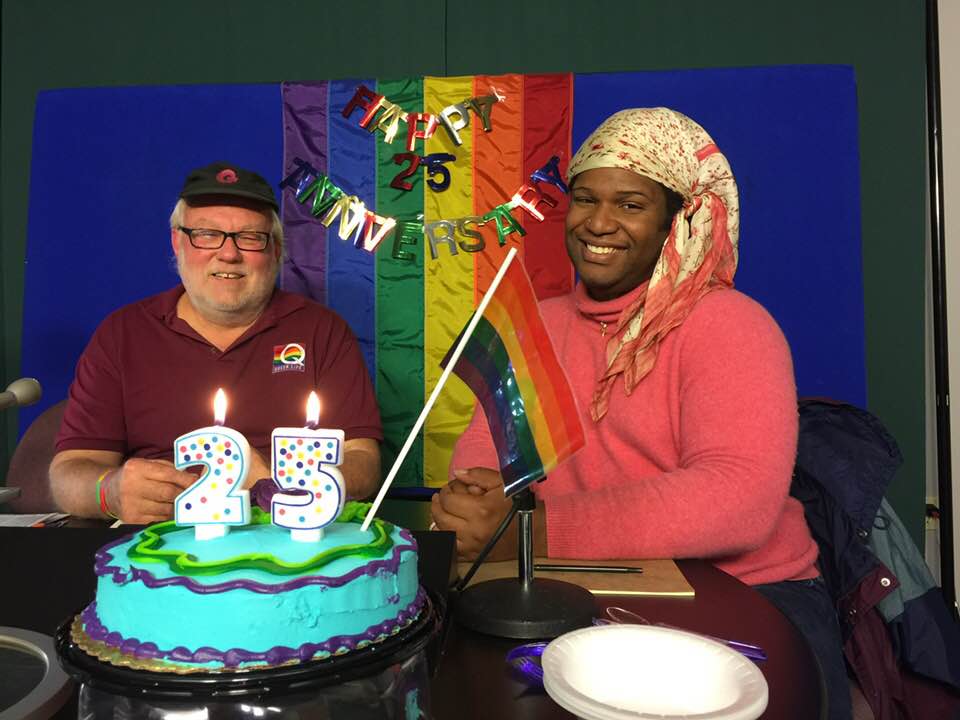
|
|
Photos: 25 years and last program
(from Michael Lisowski's Facebook page, Nov. 2017)
|
Top-of-Page |